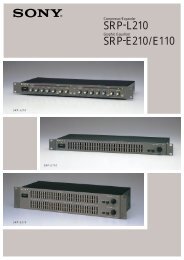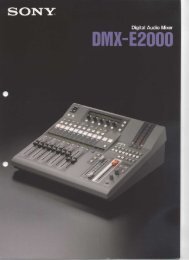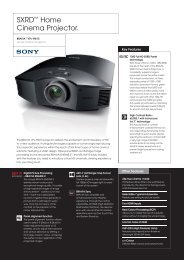APA600 APA1000 APA1400 - Altei
APA600 APA1000 APA1400 - Altei
APA600 APA1000 APA1400 - Altei
Create successful ePaper yourself
Turn your PDF publications into a flip-book with our unique Google optimized e-Paper software.
3.4. Subsonic filter<br />
This filter cuts off inaudible frequency components which when amplified suppose a<br />
risk of damage to the low frequency speakers as they generate excessive excursions of the<br />
woofer's diaphragm. The APAs feature a switchable, Butterworth shaped Subsonic Filter<br />
located inside the unit (see figure 1) with a 25Hz cut-off frequency and 18dB/oct slope.<br />
Subsonic filters are very important when playing back vinyl records because the<br />
phono cartridges are specially sensitive to feedback and acoustic coupling at very low<br />
frequencies.<br />
APA amplifiers are delivered with switched ON Subsonic Filter.<br />
CAUTION: Changes on the Subsonic Filter have to be performed by a qualified<br />
technician.<br />
3.5. Limiter circuit<br />
This system is an always active protection inside the APA series of amplifiers. The<br />
ANTICLIP circuitry constantly analyses harmonic distortion caused by excessive signal<br />
excursion at the power amplifier's output and automatically reduces the input level in order<br />
never to exceed 1% total harmonic distortion. The APA range of amplifiers are delivered with<br />
the anticlip system adjusted at a threshold of 1% THD (hard limiting). However, this value can<br />
be switched to a softer limiting (5% THD) via an internal jumper (see figure 2).<br />
The great convenience of such a circuit in any kind of installation has to be remarked:<br />
The clear advantage of a limiting system in front of conventional compressors is that the former<br />
does practically not alter the dynamic range, acting only when the distortion threshold is<br />
reached.<br />
CAUTION: Changes on the ANTICLIP configuration have to be performed by a qualified<br />
technician.<br />
3.6. Output connections<br />
The OUTPUT section on the rear panel features Speak-on connectors (12).<br />
Whenever you need to operate the amplifier in BRIDGED mode (mono or bridged), you must set<br />
the “STEREO BRIDGED" Switch (16) to BRIDGED. The input signal is taken from the INPUT<br />
connector on channel I (20) and the signal output to the loudspeaker is on pins 2+ and 2- of<br />
the Speak-on connector “CH1”. The same contacts (2+ and 2-) of the Speak-On connector of<br />
CH2 also carry the bridged signal in order to facilitate the parallel connection of loudspeakers.<br />
ATTENTION: Terminals 1+, 1- must only be used in STEREO operation and terminals<br />
2+, 2- in BRIDGED operation. Other combinations would lead to poor output quality.<br />
When operating in BRIDGED mode, always make sure that the resulting load impedance of the<br />
installation is never below 4 Ohm.<br />
The connection cable that joins the amplifiers outputs and the loudspeakers must be of<br />
good quality, sufficient section and as short as possible. This is most important when the<br />
distances to cover are long ones i.e. up to 10 meters it is recommended to use a section not<br />
inferior to 2.5mm 2 and for superior distances 4mm 2 .<br />
7





